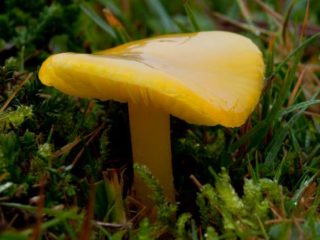Content
Pseudohygrocybe cantharellus, another name is Hygrocybe cantharellus. Belongs to the Hygrophoraceae family, department Basidiomycetes.

The mushroom has a standard structure, consisting of a stem and a cap.
What does Pseudohygrocybe chanterelles look like?
A distinctive feature of mushrooms of the Hygrophoraceae family is the small size of the fruiting body and bright color. Pseudohygrocybe chanterelle can be orange, ocher with a scarlet tint, or bright red. During the growing season, the shape of the upper part of the lamellar mushroom changes, the color of both young and adult specimens remains the same.
The external description of Pseudohygrocybe chanterelles is as follows:
- At the beginning of growth, the cap is round-cylindrical, slightly convex, in adult specimens it is spread out with concave smooth edges. A depression is formed in the center, the shape resembles a wide funnel.
- The protective film is unevenly colored, in the area of the recess it may be a shade darker, dry, and velvety. Radial longitudinal lines are clearly defined along the edge.
- The surface is smooth, finely scaly, the main accumulation of scales is in the central part of the cap. Towards the edge the coating thins out and turns into fine pile.
- The hymenophore is formed by wide but thin plates with smooth edges, shaped like an arc or triangle. They are located rarely, descending onto the leg. The color of the spore-bearing layer is beige with a yellow tint and does not change during the growing season.
- The leg is thin, grows up to 7 cm, the surface is flat and smooth.
- The upper part is the color of the cap, the lower part can be lighter.
- The structure is fibrous, fragile, the stem is hollow inside. The shape is cylindrical, slightly compressed. In the mycelium it is wider; thin white filaments of mycelium are visible on the surface near the substrate.
The flesh is thin, cream-colored in mushrooms with an orange color; if red predominates in the color of the fruiting body, the flesh is yellowish.

The central part in the funnel area is painted in a darker color

The species grows in compact, few families without forming colonies
Where does Pseudohygrocybe chanterelles grow?
The cosmopolitan mushroom Pseudohygrocybe chanterelles is common in Asia, Europe, and America. In Russia, the main concentration of the species is in the European part, in the Far East; it is less common in the southern regions and the North Caucasus. Fruiting from the second half of June to September; in mild climates, the last fruiting bodies occur in October.
The mushroom is found in all types of forests, preferring mixed ones, but can also grow in coniferous forests. It forms small scattered groups on moss litter, along the sides of forest roads; Pseudohygrocybe chanterelles is also found among meadow grasses. Less often it settles on rotting, mossy wood.
Is it possible to eat Pseudohygrocybe chanterelles?
The pulp is thin and fragile, without taste or smell.There is no information about the toxicity of the mushroom.
Conclusion
Pseudohygrocybe chanterelle is a small mushroom with a bright color and has no nutritional value. Grows in temperate climate zones and regions with mild climates - from June to October. Found in meadows and all types of forests among mosses and leaf litter.








